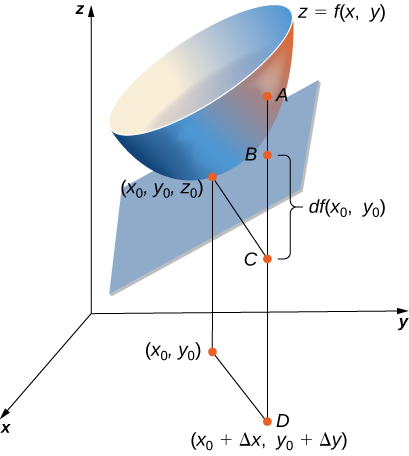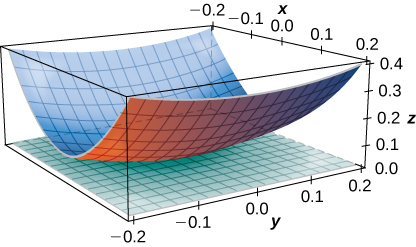Tangent Planes, Linear Approximations, and the Total Differential (Exercises)
- Page ID
- 21020
( \newcommand{\kernel}{\mathrm{null}\,}\)
In exercises 1 - 2, find a unit normal vector to the surface at the indicated point.
1) f(x,y)=x3,(2,−1,8)
- Answer
- (√145145)(12ˆi−ˆk)
2) ln(xy−z)=0 when x=y=1
In exercises 3 - 7, find a normal vector and a tangent vector at point P.
3) x2+xy+y2=3,P(−1,−1)
- Answer
- Normal vector: ˆi+ˆj, tangent vector: ˆi−ˆj
4) (x2+y2)2=9(x2−y2),P(√2,1)
5) xy2−2x2+y+5x=6,P(4,2)
- Answer
- Normal vector: 7ˆi−17ˆj, tangent vector: 17ˆi+7ˆj
6) 2x3−x2y2=3x−y−7,P(1,−2)
7) zex2−y2−3=0,P(2,2,3)
- Answer
- Normal vector: −12ˆi+12ˆj−ˆk or 12ˆi−12ˆj+ˆk,
Tangent vector: 0ˆi+1ˆj+12ˆk or 1ˆi+0ˆj−12ˆk
In exercises 8 - 19, find the equation for the tangent plane to the surface at the indicated point. (Hint: If the given function is not already solved for z, start by solving it for z in terms of x and y.)
8) −8x−3y−7z=−19,P(1,−1,2)
9) z=−9x2−3y2,P(2,1,−39)
- Answer
- −36x−6y−z=−39
10) x2+10xyz+y2+8z2=0,P(−1,−1,−1)
11) z=ln(10x2+2y2+1),P(0,0,0)
- Answer
- z=0
12) z=e7x2+4y2,P(0,0,1)
13) xy+yz+zx=11,P(1,2,3)
- Answer
- 5x+4y+3z−22=0
14) x2+4y2=z2,P(3,2,5)
15) x3+y3=3xyz,P(1,2,32)
- Answer
- 4x−5y+4z=0
16) z=axy,P(1,1a,1)
17) z=sinx+siny+sin(x+y),P(0,0,0)
- Answer
- 2x+2y−z=0
18) h(x,y)=ln√x2+y2,P(3,4)
19) z=x2−2xy+y2,P(1,2,1)
- Answer
- −2(x−1)+2(y−2)−(z−1)=0
In exercises 20 - 25, find parametric equations for the normal line to the surface at the indicated point. (Recall that to find the equation of a line in space, you need a point on the line, P0(x0,y0,z0), and a vector ⇀v=⟨a,b,c⟩ that is parallel to the line. Then the equations of the line are: x=x0+at,y=y0+bt,z=z0+ct.)
20) −3x+9y+4z=−4,P(1,−1,2)
21) z=5x2−2y2,P(2,1,18)
- Answer
- x=20t+2,y=−4t+1,z=−t+18
22) x2−8xyz+y2+6z2=0,P(1,1,1)
23) z=ln(3x2+7y2+1),P(0,0,0)
- Answer
- x=0,y=0,z=t
24) z=e4x2+6y2,P(0,0,1)
25) z=x2−2xy+y2 at point P(1,2,1)
- Answer
- x−1=2t;y−2=−2t;z−1=t
In exercises 26 - 28, use the figure shown here.

26) The length of line segment AC is equal to what mathematical expression?
27) The length of line segment BC is equal to what mathematical expression?
- Answer
- The differential of the function z(x,y)=dz=fxdx+fydy
28) Using the figure, explain what the length of line segment AB represents.
29) Show that f(x,y)=exyx is differentiable at point (1,0).
- Answer
- Using the definition of differentiability, we have exyx≈x+y.
30) Show that f(x,y)=x2+3y is differentiable at every point. In other words, show that Δz=f(x+Δx,y+Δy)−f(x,y)=fxΔx+fyΔy+ε1Δx+ε2Δy, where both ε1 and ε2 approach zero as (Δx,Δy) approaches (0,0).
- Answer
- Δz=2xΔx+3Δy+(Δx)2.(Δx)2→0 for small Δx and z satisfies the definition of differentiability.
31) Find the total differential of each function:
- z=x3+y3−5
- z=exy
- z=ycosx+siny
- P=t2+3t+tu3
- w=eycos(x)+z2
- Answers:
-
- dz=3x2dx+3y2dy
- dz=yexydx+xexydy
- dz=−ysinxdx+(cosx+cosy)dy
- dP=(2t+3+u3)dt+3tu2du
- dw=−eysin(x)dx+eycos(x)dy+2zdz
32) a. Find the total differential dz of the function z=xyy+x and then
b. State its value where x changes from 10 to 10.5 and y changes from 15 to 13.
- Answer
- a. dz=y2(x+y)2dx+x2(x+y)2dy
b. dx=0.5 and dy=−2 so
dz=fx(10,15)dx+fy(10,15)dy=152252dx+102252dy=225625(0.5)+100625(−2)=925(12)+425(−2)=18100−32100=.18−.32=−0.14
33) Let z=f(x,y)=xey. State its total differential. Then compute Δz from P(1,2) to Q(1.05,2.1) and then find the approximate change in z, dz, from point P to point Q. Recall Δz=f(x+Δx,y+Δy)−f(x,y), and dz and Δz should be approximately equal, if dx and dy are both reasonably small.
- Answer
- Total Differential: dz=eydx+xeydy
Δz≈1.185422 and dz≈1.108. Note that they are relatively close.
34) The volume of a right circular cylinder is given by V(r,h)=πr2h. Find the differential dV. Interpret the formula geometrically.
- Answer
- dV=2πrhdr+πr2dh
35) See the preceding problem. Use differentials to estimate the amount of aluminum in an enclosed aluminum can with diameter 8.0cm and height 12cm if the aluminum is 0.04 cm thick.
- Answer
- 16cm3
36) Use the differential dz to approximate the change in z=√4−x2−y2 as (x,y) moves from point (1,1) to point (1.01,0.97). Compare this approximation with the actual change in the function.
37) Let z=f(x,y)=x2+3xy−y2. Find the exact change in the function and the approximate change in the function as x changes from 2.00 to 2.05 and y changes from 3.00 to 2.96.
- Answer
- Δz= exact change =0.6449, approximate change is dz=0.65. The two values are close.
38) The centripetal acceleration of a particle moving in a circle is given by a(r,v)=v2r, where v is the velocity and r is the radius of the circle. Approximate the maximum percent error in measuring the acceleration resulting from errors of 3% in v and 2% in r. (Recall that the percentage error is the ratio of the amount of error over the original amount. So, in this case, the percentage error in a is given by daa.)
39) The radius r and height h of a right circular cylinder are measured with possible errors of 4% and 5%, respectively. Approximate the maximum possible percentage error in measuring the volume (Recall that the percentage error is the ratio of the amount of error over the original amount. So, in this case, the percentage error in V is given by dVV.)
- Answer
- 13% or 0.13
40) The base radius and height of a right circular cone are measured as 10 in. and 25 in., respectively, with a possible error in measurement of as much as 0.1 in. each. Use differentials to estimate the maximum error in the calculated volume of the cone.
41) The electrical resistance R produced by wiring resistors R1 and R2 in parallel can be calculated from the formula 1R=1R1+1R2. If R1 and R2 are measured to be 7Ω and 6Ω, respectively, and if these measurements are accurate to within 0.05Ω, estimate the maximum possible error in computing R. (The symbol Ω represents an ohm, the unit of electrical resistance.)
- Answer
- 0.025
42) The area of an ellipse with axes of length 2a and 2b is given by the formula A=πab. Approximate the percent change in the area when a increases by 2% and b increases by 1.5%.
43) The period T of a simple pendulum with small oscillations is calculated from the formula T=2π√Lg, where L is the length of the pendulum and g is the acceleration resulting from gravity. Suppose that L and g have errors of, at most, 0.5% and 0.1%, respectively. Use differentials to approximate the maximum percentage error in the calculated value of T.
- Answer
- 0.3%
44) Electrical power P is given by P=V2R, where V is the voltage and R is the resistance. Approximate the maximum percentage error in calculating power if 120V is applied to a 2000−Ω resistor and the possible percent errors in measuring V and R are 3% and 4%, respectively.
For exercises 45 - 49, find the linear approximation of each function at the indicated point.
45) f(x,y)=x√y,P(1,4)
- Answer
- L(x,y)=2x+14y−1
46) f(x,y)=excosy;P(0,0)
47) f(x,y)=arctan(x+2y),P(1,0)
- Answer
- L(x,y)=12x+y+14π−12
48) f(x,y)=√20−x2−7y2,P(2,1)
49) f(x,y,z)=√x2+y2+z2,P(3,2,6)
- Answer
- L(x,y,z)=37x+27y+67z
50) [T] Find the equation of the tangent plane to the surface f(x,y)=x2+y2 at point (1,2,5), and graph the surface and the tangent plane at the point.
51) [T] Find the equation for the tangent plane to the surface at the indicated point, and graph the surface and the tangent plane: z=ln(10x2+2y2+1),P(0,0,0).
- Answer
-
z=0

52) [T] Find the equation of the tangent plane to the surface z=f(x,y)=sin(x+y2) at point (π4,0,√22), and graph the surface and the tangent plane.
Contributors
Gilbert Strang (MIT) and Edwin “Jed” Herman (Harvey Mudd) with many contributing authors. This content by OpenStax is licensed with a CC-BY-SA-NC 4.0 license. Download for free at http://cnx.org.
- Paul Seeburger (Monroe Community College) created all but part e of exercise 31.

